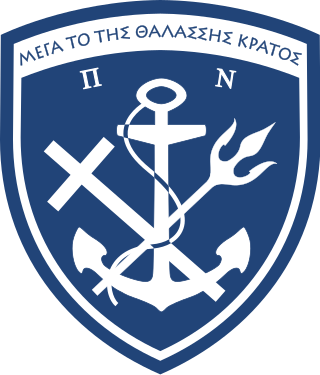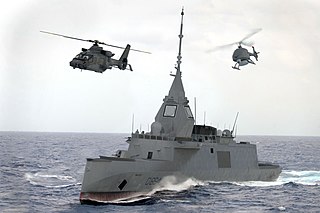
The Hellenic Navy is the naval force of Greece, part of the Hellenic Armed Forces. The modern Greek navy historically hails from the naval forces of various Aegean Islands, which fought in the Greek War of Independence. During the periods of monarchy it was known as the Royal Hellenic Navy.
The history of the Hellenic Navy begins with the birth of modern Greece, and due to the maritime nature of the country, this force has been the premier service of the Greek Armed Forces.

Georgios Averof is a modified Pisa-class armored cruiser built in Italy for the Royal Hellenic Navy in the first decade of the 20th century. The ship served as the Greek flagship during most of the first half of the century. Although popularly known as a battleship (θωρηκτό) in Greek, she is in fact an armored cruiser, the only ship of this type still in existence.

The Asheville-class gunboats were a class of small warships built for the United States Navy in response to the Cuban Missile Crisis. The class is named for a city in western North Carolina and the seat of Buncombe County. All Asheville-class gunboats have since been donated to museums, scheduled for scrapping, or transferred to the Greek, Turkish, Colombian and South Korean Navies. The last two Asheville-class gunboats in US service were USS Chehalis and USS Grand Rapids, which were operated by the Naval Surface Warfare Center until they were stricken in 2016.

The HSY-55-class gunboat is a class of naval vessel designed by the Hellenic Navy and built by Hellenic Shipyards (HSY). This class of ship uses the modular concept, so that weapons & sensors can be changed as required. These vessels are similar in appearance to Osprey 55-class gunboat. The first pair was ordered on 20 February 1990 but completion was delayed by the shipyard's financial problems. Pyrpolitis (P57) was launched on 16 September 1992 and Polemistis (P61) on 21 June 1993. Each ship can carry 25 fully equipped troops. Alternative guns & Harpoon SSM can be fitted, as required.

The Osprey HSY-56A-class gunboat is a class of naval vessel currently in service in the Hellenic Navy. These ships are similar to HSY-55-class gunboat and were also built by Hellenic Shipyards (HSY). They are the most modern patrol vessels of Hellenic Navy. The first ship of the class, named Machitis, was commissioned on 29 October 2003. As of 2018, all of the four ships of the class are in active service.

The Aetos class were four destroyers were originally constructed for the Argentine Navy as the San Luis class. In Greek they are known as the Thiria class, after the ships' names. They were purchased by the Royal Hellenic Navy in October 1912 when the Greek government expanded its navy after losing the Greco-Turkish War of 1897 and in anticipation of the Balkan Wars. In December 1916, during World War I, three of the destroyers were seized by France and served in the French Navy until 1918, all except Panthir. They were returned to Greece in 1918. In 1924–1925, they were extensively rebuilt and continued in service into World War II, where they fought with the Allies. Leon was sunk by German aircraft at Suda Bay, Crete. The other three destroyers survived the war and were used as station ships during the Greek Civil War. They were discarded in 1946.

The João Coutinho-class corvettes were a series of warships built for the Portuguese Navy for service in Portugal's African and Indian colonies. Initially rated as frigates, they were downgraded first to corvettes and then patrol vessels with age. They were designed in Portugal by naval engineer Rogério de Oliveira, but the urgent need of their services in the Portuguese Colonial War meant that the construction of the ships was assigned to foreign shipyards. Six ships were built; the first three ships were built by Blohm & Voss and the remaining three by Empresa Nacional Bazán. The ships were launched in 1970 and 1971. The relative cheap cost of the design led to it being the basis of several other classes in other navies. From 1970 until the end of the conflict in 1975, the corvettes were used for patrol and fire-support missions in Angola, Mozambique, Guinea and Cape Verde. After the African colonies gained their independence, the corvettes were assigned to patrol duties in Portuguese territorial waters.

Hydra (F-452) is the lead ship of the Greek Hydra-class frigate and flagship of the Hellenic Navy. The ship was built in the same shipyard as the Blohm + Voss MEKO 200 frigate class, on which its design was based. Three more vessels were built by Hellenic Shipyards Co. at Skaramagas in following years. It is the fifth ship in the Hellenic Navy to bear the name Hydra.

The Roussen class is a seven-strong class of British-designed fast attack missile boats improved and customized for the Hellenic Navy, also known as Super Vita. The class is named after its lead ship, which in turn is named after Lt Nikolaos Roussen, a World War II submarines officer who was killed in the suppression of the Navy mutiny in April 1944.

USS Defiance (PGM-95/PG-95) was a gunboat in the United States Navy and later transferred to Turkey. She was an Asheville-class gunboat, and the third ship to be named Defiance, in honor of the city of Defiance, Ohio.

Limnos (F451) is an Elli-class frigate of the Hellenic Navy, and the third Greek warship to bear the name. The class is based on the Royal Netherlands Navy's Kortenaer class and was built in a Dutch shipyard; however, unlike later members of her class in the Hellenic Navy, she was not originally in Dutch service but was sold directly to Greece. Limnos was constructed in Vlissingen, Netherlands, along with her sister ship Elli. The contract for her construction was signed in Athens in July 1981, and her commissioning took place on 18 September 1982. After commissioning, Limnos joined the Hellenic Fleet on 5 November 1982, and, since then, she has actively participated in its activities.

The Frégate de Défense et d'Intervention or FDI, formerly denominated Frégate de Taille Intermédiaire or FTI, is a programme launched in 2015 to produce a new class of first-rank French frigates to complement the Aquitaine-class. As of February 2022, five ships have been ordered for the French Navy and will form the Amiral Ronarc'h class, with the lead ship expected to be commissioned in 2025. In 2021, three units were ordered by Greece for the Hellenic Navy and will form the Kimon-class.

The seafaring of the inhabitants of the Greek mountain village Litochoro has a long tradition which is represented in the Maritime Museum.

The Hellenic Naval Band is a Greek military band which was established in 1880. It is located at the military base in Votanikos, Athens. For more than a century, the band has performed at major state events in Greece on behalf of the Hellenic Navy, as well as on radio and television, and toured extensively abroad. The band participated in the opening ceremony of the 1896 Summer Olympics and in the 2004 Summer Olympics, as well as in several military music festivals in the Europe. The current bandmaster of the band is Lieutenant Commander Georgios Tsilibaris.

HNLMS Kortenaer (F807) was a frigate of the Kortenaer class. The ship was in service with the Royal Netherlands Navy from 1978-97 and today serves as HS Kountouriotis with the Hellenic Navy. The frigate was initially named after Dutch naval hero Egbert Bartholomeusz Kortenaer and then after Pavlos Kountouriotis, distinguished Admiral of the Hellenic Navy, responsible for Greek naval victories in the Aegean Sea that secured the Aegean for Greece during the First Balkan War. The ship's radio call sign was "PADA".

Georgios Blessas was a Greek naval commander who participated in the Second World War.

The Kimon class, also known as the FDI HN, is a frigate class for the Hellenic Navy. The FDI HN is a more heavily armed version of the French frigates. The lead ship is expected to be commissioned in early 2025.


















